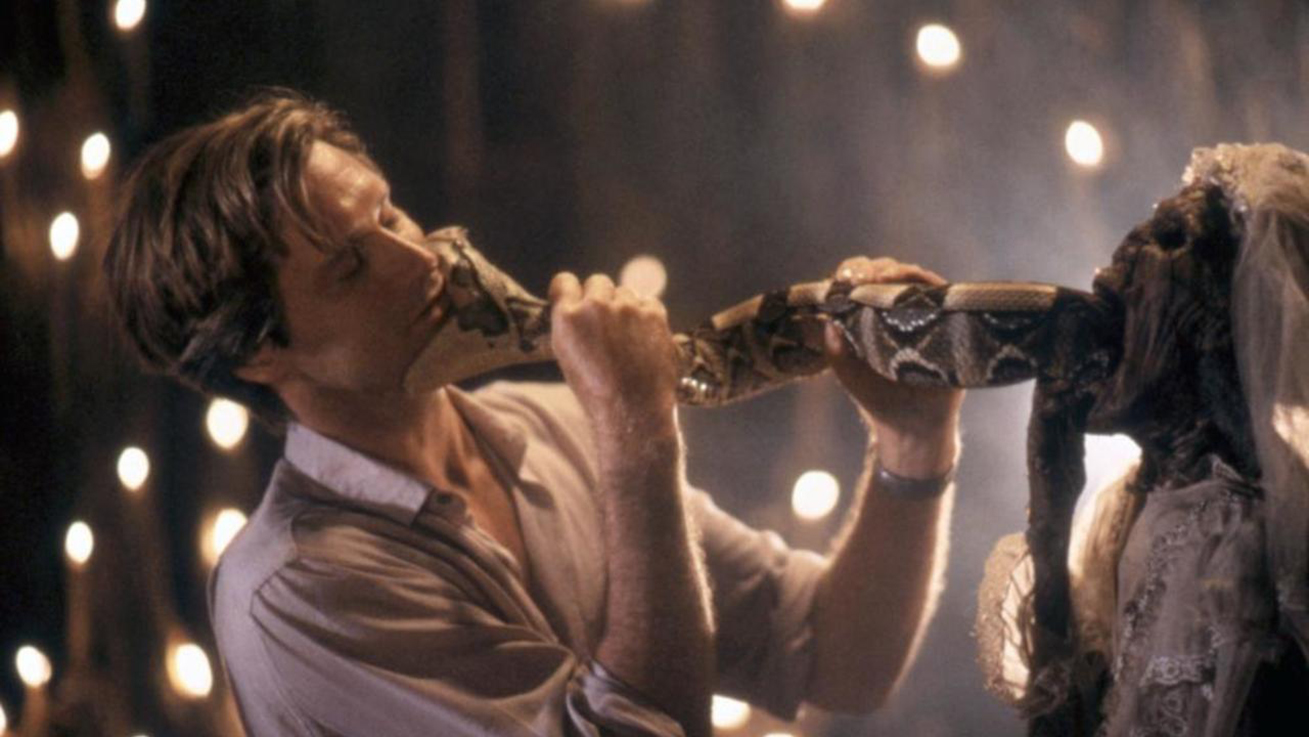In 1988, between the eras of Craven’s filmmaking styles came one of the creepiest, most well-written, and possibly the most underrated films of his career. 35 years ago, The Serpent and the Rainbow was released. Unlike most of Craven’s films, he didn’t write this one. Instead, the screenplay was written by Richard Maxwell and Adam Rodman and was based on the 1985 true story written by Wade Davis, titled The Serpent and the Rainbow: A Harvard Scientist’s Astonishing Journey into the Secret Societies of Haitian Voodoo, Zombis, and Magic.
“In the legends of voodoo,
the Serpent is a symbol of Earth.The Rainbow is a symbol of Heaven.
Between the two, all creatures must live and die.
But because he has a soul,
Man can be trapped in a terrible placeWhere death is only the beginning”
It’s undeniable that the horror genre simply wouldn’t be the same without Wes Craven. Love his movies or hate them, he’s the only horror director responsible for the creation of two of the most lasting, iconic slasher villains in Freddy Krueger and Ghostface, even multiple decades past their introductions.
Before he directed A Nightmare on Elm Street, Craven had gotten attention for helming raw, chill-inducing, realistic horror films like Last House on the Left and The Hills Have Eyes. After his introduction of Freddy, Craven toned things down and geared more toward horror satire films in the ‘90s, like New Nightmare, Vampire in Brooklyn, and Scream.

For those unfamiliar (go watch it!), The Serpent and the Rainbow follows Harvard anthropologist Dennis Alan (played brilliantly by Bill Pullman) as he ventures to Haiti in hopes of studying medicines with a shaman. Upon arrival, Dennis is approached by a pharmaceutical company about a local potion that has the power to raise the dead to a zombie-like state. Dennis decides to investigate the claims and finds that the path goes to darker places than he can imagine.
In a major shift from his other films, Craven brought the viewer into unfamiliar territory by setting the film in Haiti, which added a level of isolation for both us and the main character. In a way, this helps the viewer connect to Alan Dennis more. Not only are the supernatural elements of the film scary, but so is the environment and those who wish Dennis dead before he can uncover more secrets.
Related: ‘Hollywood Dreams & Nightmares: The Robert Englund Story’ To Get a Theatrical Release
Death is everywhere the main character turns… quite literally. Because of real-life political conflict, the cast and crew were warned by the local government that their safety could not be guaranteed. Things got so bad that the filming had to be moved to the Dominican Republic. Scared looks on the cast and crew’s faces were likely real reactions to the threats against their safety.
The Serpent and the Rainbow brought forth incredibly uncomfortable and disturbing dream sequences. Where A Nightmare on Elm Street focused more on the slasher, this film relied more on the realistic fears that haunt the viewers’ dreams; suffocating, being buried alive, drowning (in blood), and being attacked by wild animals. The nightmares don’t end when the character wakes up, though.

There’s a particularly brutal torture scene involving Bill Pullman’s genitals, a hammer, and some extra-long nails. There’s another scene where a possessed woman chews on glass. These types of scenes created a physical reaction in the viewers, not just a laugh at a silly kill or a slight wince.
And this isn’t even including the terrifying practical effects and fantastic set design, some of the best of Craven’s career. If you’ve never seen a snake shoot out of a corpse’s mouth and bite a man in the face, this one’s for you.
Related: The Best Horror Movie of Each Decade from the Last Century
The Serpent and the Rainbow held a level of realistic creepiness that hadn’t been seen in Craven’s films for some time at that point. After The Hills Have Eyes, but before this, Craven had done A Nightmare on Elm Street, Swamp Thing, Deadly Blessing, Chiller, and Deadly Friend… not exactly the most serious run of films.

One of my favorite things about the film was its deep dive into Haitian culture, science, and realistic voodoo. Too often in horror has voodoo been reduced to an over-the-top character with a doll. But real voodoo involves losing control, and there are few things scarier than being unable to control yourself while still being aware of the horrific acts you’re committing. Does it get more petrifying than not knowing whether your actions are based on reality or a hallucination?
Of course, the focus on tetrodotoxin (pufferfish venom) as the “zombie powder” that has been used in so many horror films and TV shows since this movie is kind of a foundation from a trope, and the science nerd in me loves it.
A large part of me wishes that Wes Craven had spent the 2000s going back to his roots and doing more films like The Serpent and the Rainbow instead of various Scream sequels, Cursed, and My Soul to Take, as I believe it was in films like this that we got a clear, concise look at the director’s true style and ability. Don’t get me wrong, some of those films were perfectly fine and fun, but The Serpent and the Rainbow was one of Craven’s best.


















